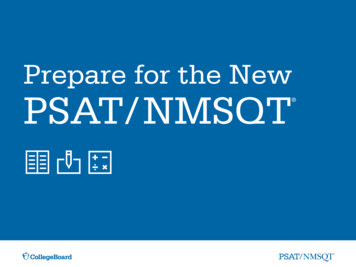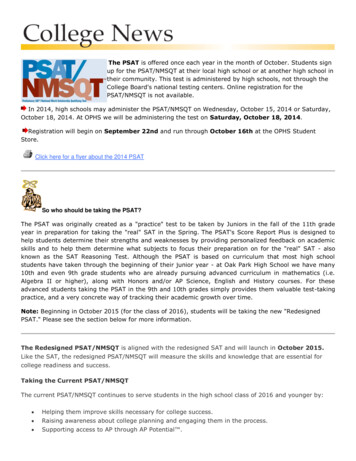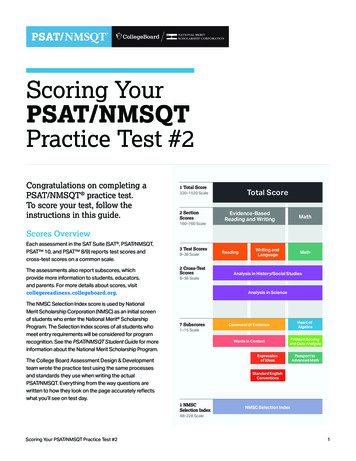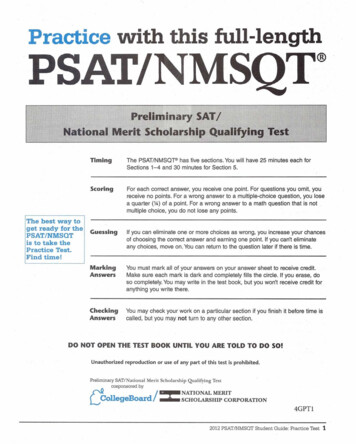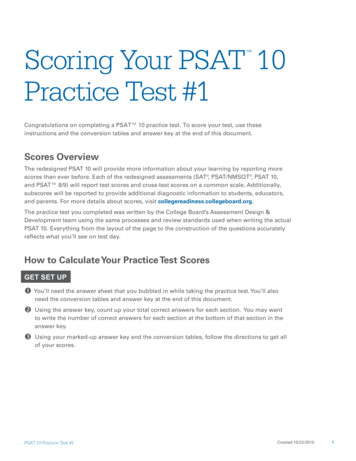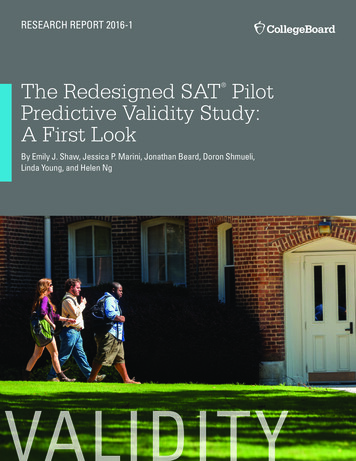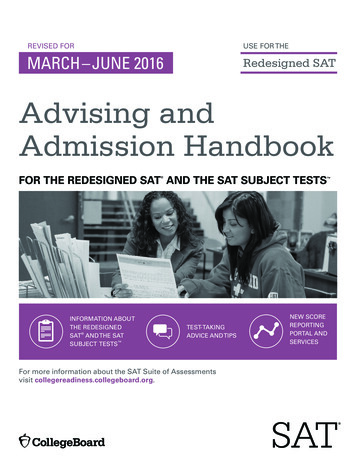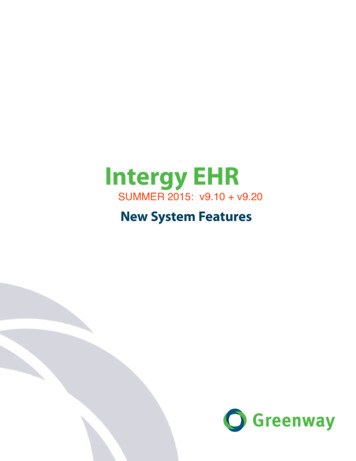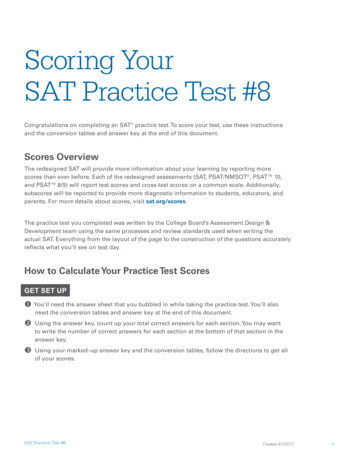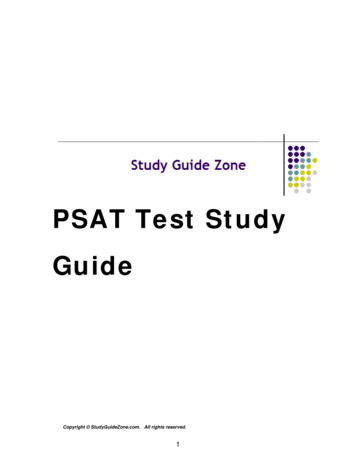
Transcription
PREVIEW OF THEREDESIGNEDPSAT/SATWalnut Hills High School, College Information CenterMrs. Martha Geller and Mrs. Kathy Restle
The Middle, “The Test”
Program overview Why is this happening? What are the changes? When do the changes take place? Who takes which test? How can students prepare?
Why is this happening?
College Board’s definitionHigh school graduates who are college and careerready have a high likelihood of successfully enteringsome type of postsecondary education (i.e., four-yearinstitution, two-year institution, trade school, technicalschool, and/or workforce training program) withoutremediation. Research shows that the thresholdreading and math skills required for college readinessare essentially the same as those required for careertraining readiness, meaning that sharply differentiatedforms of preparation aren’t required.Source: “Test Specifications for the Redesigned SAT,” College Board
Why is this happening? 2013 cohort results: only 43% of all SAT takersreached the “College and Career Readiness”benchmark: a score of 1550 or better, predicting a90% likelihood of earning a “C” or better in collegeentry courses without remediation 2012: first year total number of students taking theACT overtook the SAT128% increase in ACT takers68% increase in SAT takers
What are the changes? The redesigned SAT requires students to: Read, analyze and use reasoning to comprehendchallenging literary and informational texts in order todemonstrate and expand knowledge and understanding Revise and edit extended texts to show facility with a coreset of grammar, usage and punctuation conventions Show command of focused but powerful set of knowledge,skills and understandings in math and apply that ability tosolve real-world problems
What are the changes? The redesigned SAT requires students to: Makecareful and considered use of evidence Demonstrate skillin analyzing data, including datarepresented graphically Understandrelevant words in context and how wordchoice helps shape meaning and tone
8 Key Changes to the SAT 2015 The College Board
The 8 Key Changes
Vocabulary “fiery”“fire”“flame”Tier 3:PrecisionVocabularyTier 2:DescriptiveVocabularyTier 1:Basic and GeneralVocabularyLow frequency, content-specific words.Specific to subjects, hobbies,occupations, geographic regions,technology.High frequency words that occuracross a variety of subjects. Mayhave multiple meanings and/orsynonyms.Used within mature languagesituations such as adultconversions and literature.The most basic words ofeveryday speech. Rarelyrequire direct instructionand do not have multiplemeanings.
Relevant words in context
The 8 Key Changes
Command of evidence
The 8 Key Changes
Redesigned SAT essay prompt12[Sample Passage here](In this example , passage is adapted from “Why Literature Matters” byDana Gioia. 2005 by The New York Times Company. Originally publishedApril 10, 2005.)3
The 8 Key Changes
Problem solving and data analysis
Heart of AlgebraMr. Ferd Schneider,WHHS AP Calculus teacher
Passport to Advanced Math
Non-calculator problem
The 8 Key Changes
Problems grounded in real-world contexts
The 8 Key Changes
Analysis in science and social studies
The 8 Key Changes
The 8 Key Changes
Grade Level Appropriate ReadingPSAT 8/9PSAT 10 & PSAT/NMSQTSATDraw fairly simple, one-stepconclusions spelled out clearly inthe textDraw a more subtle inference to Perform several steps to draw thereach the right conclusion from a right conclusion from a texttextIdentify relationships based onmultiple, fairly straightforwardpieces of info stated in the textInfer somewhat morecomplicated relationships basedon more subtle pieces of infostated in the textDetermine explicit meaning from Recognize trends in graphicalthe graphic or textdataInfer more complex relationshipsfrom the text by piecing facts orincidents togetherSynthesize information from agraphic and passage 2015 The College Board
Grade Level Appropriate Writing & LanguagePSAT 8/9PSAT 10 & PSAT/NMSQTSATUse punctuation effectively insimple contexts, such as usingcommas to separate items in alistUse punctuation effectively insomewhat challenging contexts,such as using a colon to introducea listUse punctuation effectively inchallenging contexts, such asusing a semicolon to linkindependent clausesEdit straightforward sentencesthat pose some challenge, such assentences with an introductoryphraseEdit compound and complexsentences, including sentenceswith introductory phrases andclausesEdit syntactically challengingsentences, such as lengthysentences that include severalclausesAccurately incorporate basicinformation from graphics into atextAccurately incorporate somewhat Incorporate accurate, specific,detailed or nuanced information and complex information fromfrom graphics into a textgraphics into a text 2015 The College Board
Grade Level Appropriate MathPSAT 8/9PSAT 10 & PSAT/NMSQTSATMany items requiring one or twosteps to solveMany items requiring 2 or moresteps to solveEmphasis on multi-step problemsMay require the use of commongeometric equationsMay require the use of commongeometric equations and spatialreasoningRequires the use of geometryconcepts and reasoningIncludes ratios, proportions,Requires comparing linear andpercents, introductory probability exponential growthand statisticsIncludes statistics topics such assampling and inferring correlationand causation form a researchmethodMay require the use of propertiesRequires the use of trigonometric Requires the use of trigonometryof right triangles to solverelationshipsproblems 2015 The College Board
Redesigned SAT: 3 sectionsEvidence-basedreading andwritingMath200-800 points200-800 pointsEssay3 hoursPlease note: precise timing is tentative andsubject to research.50 minutes
SAT Scores and Subscores 2015 The College Board
When are the changes taking place?REDESIGNED PSATOctober 2015 9th– PSAT 9 10th – PSAT/NMSQT 11th – PSAT/NMSQTSATJanuary 2016last administration ofcurrent SATMarch 2016first administration ofredesigned SAT
Who takes which test? Current 9th graders: first class to take only theredesigned PSAT and SAT Current 10th graders: class with option of takingthe current SAT prior to March 2016 and theredesigned SAT starting in March 2016 Colleges areprepared and expecting that studentsapplying to start college in fall 2017 may have scores fromthe current and redesigned tests.
Who takes which test?Considerations for 10th graders:Really like your results onPSAT in October 2014?Then, consider taking thecurrent SAT.March 2016first administration ofredesigned SATSATJanuary 2015last administration ofcurrent SATNot certain if the SAT is foryou based on PSAT inOctober 2014?Then, wait to evaluatePSAT scores fromOctober 2015.
AND . . . Don’t forget about the ACT! ALL JUNIORS SHOULD TAKE THE ACT INDECEMBER 2015! Why? Goodtiming to allow comparison of ACT score withprojected SAT from October’s PSAT and future SAT scores Test dateoffers return of “Test Information Release” return of test booklet and expanded score report Students canpractice based on these results for the CPSfunded ACT in April 2016
AND . . . Don’t forget about the ACT!Want an early experience withthe ACT or a baseline score?Consider taking the ACT on June 13.ACT Register at www.act.org by May 8. Take advantage of “Test InformationRelease” for additional 20.Alternative: simulated ACT athome using CIC test copy
How can students prepare? Use resources in College Information Center Lunchtime review sessions Individualized and small group tutoring Test copies, concept review sheets and more Use College Board materials Use Khan Academy resources
Practice!
The College Board and Khan Academy havepartnered to provide online SAT testpreparation programs and resources entirelyfree of charge. Beginning in June 2015, Khan Academy willrelease an interactive and personalized practiceprogram for the redesigned SAT Features include: Thousands of practice problems Personalized tutorials on test content Official SAT practice questions andfull-length tests Comprehensive reporting for students Access anytime, anywhere — for free We are working with educators, communitygroups, college access organizations, andparents to provide the necessary resources topropel students to college success. 2015 The College Board
For more informationMartha Gellergellerm@cps-k12.org513-363-8455Kathy Restlerestlek@cps-k12.org513-363-8609SAT Websitewww.delivering opportunity.org
DECEMBER 2015! Why? Good timing to allow comparison of ACT score with projected SAT from October’s PSAT and future SAT scores Test date offers return of “Test Information Release” return of test booklet and expanded score report Students can practice ba
